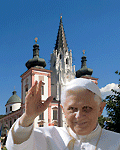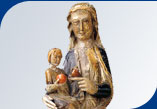ABSTRACT
The Veneration of Mary has a long tradition in Austria. Inscriptions dating back to 700 report of the Veneration of the Mother of God in Austria. The Praise of Mary has always been an integral part in convent prayer and many foundings of convents are dedicated to Mary. As a consequence of the Reformation in the 16th century, the Veneration of Mary in Austria decreased. After the defeat of the Swedish troops on May 18, 1647, Emperor Ferdinand III. dedicated His countries to the Immaculate Virgin Mary. In order not to let the dedication of Austria to Mother Mary Immaculate fall into oblivion, Cardinal Theodor Innitzer and later Christoph Cardinal Schönborn renewed the dedication on May 18, 1947 and on May 18, 1997. Today, Austria has about 200 important places of pilgrimage dedicated to Mary. The Rosary Crusade, a community praying for peace in the world, the pilgrimages to Fatima on the 13th of every month, and the many people praying the rosary prove the vividness of the Veneration of Mary in Austria. The countless pilgrims, young and old, who are on pilgrimage to sites of grace, are a source of joy. Mary's intercession appeals to many people. Looking on Mary always means to let her take us by the hand and lead us to Jesus: "Look on Christ!"
________________________________________________________________
It is a source of joy to see people of all age groups coming together at pilgrimage sites: parents with their children, teenagers and adults who have come on foot, elder people moving their lips in silent prayer: Mary's intercession appeals to many people. The Veneration of Mary has a long tradition in Austria.
As only little is known about the beginnings of Christianity in Austria, the origins of the Veneration of Mary probably trace back to antiquity.
St. Rupert, early Bishop of Worms, went to proselytize the East and founded a church and a convent in Salzburg dedicated to St. Peter in 700. Three inscriptions bearing testimony to the Veneration of Mary in Austria can be found in St. Peter's church in Salzburg. One of them says: "The Virgin Mary, Bearer of God, Light and Star of the Ocean, Queen of Our Salvation, May She Glorify this Altar Which is Dedicated to Her Honor with Her Live-Giving Merits."
The first church built in Upper Austria, of which a document of its dedication has been handed down through history, is a church dedicated to Mary. The church was consecrated by Bishop Vivilio of Passau at the Enkach (today's Neukirchen at the Enkach) in 739. The famous Marian Sanctuary in Altötting dates back to this time as well. The altars and churches dedicated to Mary pose the question which Marian Feast Days were celebrated in these times. The Salzburg Synod in 800 gives an answer: "A festive mass to the honors of the Mother of God shall take place four times a year on February 2 (Mary's Purification), on March 25 (Conception; today's Annunciation), on August 15 (Mary's Assumption), and on September 8 (Birth of Mary).
A special Marian appearance in our country must not be forgotten: in 1797, a picture of Mary mysteriously appeared to a farmer's daughter in the living room's window in Absam. Upon approval by the Bishop of Brixen, the picture was transferred to the parish church. Since then, Absams has been the most significant Marian pilgrimage site in the Tyrol.
Praise of Mary in Convents
The Cistercians have been so dedicated venerators of Mary that she was seen as owner of every convent. The Benedictines, who incorporated the veneration of Mary in their monastic rule, often put their churches and chapels under the protection of Mary. This is where the founding of Mariazell, the most famous pilgrimage site dedicated to Mary, has to be mentioned, as Pope Benedict XVI. is going on a pilgrimage to Mariazell on the occasion of Mariazell's 850th anniversary.
In 1157, a monk from the Benedictine convent St. Lambrecht was sent to the area surrounding Mariazell. Having reached Mariazell, he built a cella for the Mother of God which is mentioned in the records dating back to 1243. From 1644 to 1683, the cella was extended. Mary, the Mother of Grace, is being addressed as "Great Mother of Austria" (Magna Mater Austriae), "Mother of the Slavic Peoples," "Great Mistress of Hungary."
Bishop Altmann of Passau was a huge venerator of Mary. He did not only found Göttweig Convent and dedicate it to Mary; also, he had a great influence on the education of the Babenberg St. Leopold III.
Beginnings of the Veneration of the Immaculate Virgin Mary and Its Reactivation by the Counter-Reformation
It is noteworthy that after the establishment of the Department of Theology at the University of Vienna in 1384, famous theologians dealt with the controversial topic of the Immaculate Conception in a positive way. In 1399, the Feast of the Immaculate Conception was celebrated in Brixen, in 1476 in St. Stephen's Cathedral and in the Church "Maria am Gestade" in Vienna. The Feast of the Immaculate Conception even appears in the Vienna "Heiligthumsbüchlein," a book on feasts dating back to 1500.
As a consequence of the Reformation in the 16th century, the Veneration of the Immaculate Conception and Mary as such decreased in Austria.
The Jesuits, and other orders, such as the Servitians, the Franciscans, and the Capuchins, contributed to the renewal of the faith in the Catholic Church in Austria enormously. Also, they fostered the Veneration of Mary, especially the title "Immaculate Virgin." The influence of these orders had great effects on the Habsburg emperors Ferdinand II., Ferdinand III., and Leopold I. This makes it plausible that, after the defeat of the Swedish troops on May 18, 1647, Emperor Ferdinand III. dedicated His countries to the Immaculate Virgin Mary. On this occasion, Emperor Ferdinand III. took a vow to have the Archduchy of Austria celebrate December 8th as the day of the Immaculate Conception of Mary. In remembrance of this vow, a Marian Column was erected in front of the Church "Am Hof." Consequently, a number of copies of this Marian Column stressing Mary Immaculate were erected in other cities, such as in Innsbruck. The most fabulous memorial reminding of Mary Immaculate is the Cathedral in Linz which was consecrated in 1924 after a building period of 60 years.
In order not to let the dedication of Austria to Mother Mary Immaculate fall into oblivion, Cardinal Theodor Innitzer and later Cardinal Christoph Schönborn renewed the dedication on May 18, 1947 and on May 18, 1997.
The Dedication and Its Consequences
Was it only a coincidence that 300 years after the dedication of Austria to the Mother of God, on February 2, 1947, God's servant P. Petrus Pavlicek founded the Rosary Crusade, a community praying for peace in the world, which contributed to the freeing of the country from the four victory powers with thousands of prayers? Diocesan priest Dr. Franz Tauber had paved the way for this praying initiative by founding the Rosary Crusade in 1942.
Are we not allowed to say: the Mother of God has not forgotten the dedication of Austria in 1647 and has given new impetus to venerate her? However, a change of heart is vital for the veneration of Mary. On September 13, 1983, Pope John Paul II. entrusted the Mother of God with Austria again. We hope that on His visit to the patroness of Austria in Mariazell, Pope Benedict XVI. will renew the dedication in a suitable way. The purpose of this renewal is to raise awareness of the consequences of such a dedication in the believers. Today, Austria has about 200 important places of pilgrimage dedicated to Mary. The Rosary Crusade, a community praying for peace in the world, the pilgrimages to Fatima on the 13th of every month and the many people praying the rosary prove the vividness of the Veneration of Mary in Austria: there cannot be doubt, though, that for many believers in Austria, Mary does not play a major role in their faith.
Based on the remark of the famous exegete P. Klemens Stock SJ ("The information on Mary in the New Testament is so deep and rich that it cannot be sufficiently explored."), the Veneration of Mary must be based on the biblical sources more than ever: the lasting vocation of Mary, Servant of the Lord, which is the biblical title of Mary, is to direct us to her son Jesus, the Son of God, and to work against the waning of faith.
Father Benno Mikocki OFM
Spiritual Leader of the Rosary Crusade ("Rosenkrank-Sühnekreuzzug - RSK")




 1
1 

